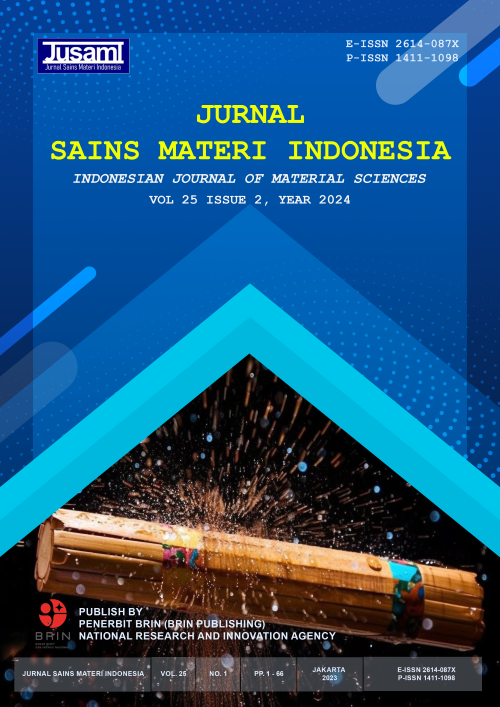Carbon Nanotube Modified Poly HEMA/CNC Composite Sorbent for Selective Recovery of Rare Earth Metal Ions
DOI:
https://doi.org/10.55981/jsmi.2024.3134Keywords:
Adsorption, Liquid crystal, Cellulose Nanocrystal, carbon nanotubes, Rare Earth ElementAbstract
Rare earth elements (REEs) from secondary resources need to be purified before being used as critical raw materials. A novel type of carbon nanotube (CNT)--based composite sorbent has been developed to adsorb REE metal ions from a low concentration of aqueous solution. The composite sorbents prepared from HEMA, CNC, and CNT were characterized by FTIR and their adsorption properties by ICP-OES. The results showed that the adsorption performance of sorbents depends on their constituting materials and the pH of the feeding solution. The presence of CNTs in the sorbents helps increase adsorption efficiency while increasing contact time. The highest adsorption efficiency (98%) was achieved at pH 4 with a contact time of 90 minutes. The prepared composite sorbents showed better adsorption selectivity for cerium (Ce3+) ions than neodymium (Nd3+) and lanthanum (La3+).
Downloads
References
J. H. L. Voncken. “Physical and chemical properties of the rare earths,” in The Rare Earth Elements: An Introduction, Springer Briefs in Earth Sciences, 2016, pp. 53–72.
A. R. Jha. Rare Earth Materials: Properties and Applications. CRC Press, 2014.
M. Humphries. “Rare earth elements: The global supply chain.” Congressional Research Service, 2010, pp. 1–20, 2011.
V. Balaram. “Rare earth elements: A review of applications, occurrence, exploration, analysis, recycling, and environmental impact.” Geosci. Front., vol. 10, no. 4, pp. 1285–1303, 2019.
H. Royen and U. Fortkamp. Rare earth elements: Purification, sustainability and recycling.” IVL Svenska Miljöinstitutet, 2016.
M. Kaya. “Recovery of metals and nonmetals from electronic waste by physical and chemical recycling processes.” Waste Manag., vol. 57, pp. 64–90, 2016.
N. N. Hidayah and S. Z. Abidin. “The evolution of mineral processing in extraction of rare earth elements using solid-liquid extraction over liquid-liquid extraction: A review.” Miner. Eng., vol. 112, pp. 103–113, 2017.
R. M. Ashour, H. N. Abdelhamid, A. F. Abdel-Magied, A. A. Abdel-Khalek, M. M. Ali, A. Uheida, M. Muhammed, X. Zou, and J. Dutta. “Rare earth ions adsorption onto graphene oxide nanosheets.” Solvent Extr. Ion Exch., vol. 35, no. 2, pp. 91–103, 2017.
C. E. D. Cardoso, J. C. Almeida, C. B. Lopes, T. Trindade, C. Vale, and E. Pereira. “Recovery of rare earth elements by carbon-based nanomaterials—A review.” Nanomaterials, vol. 9, no. 6, 2019.
S. Tong, S. Zhao, W. Zhou, R. Li, and Q. Jia. “Modification of multi-walled carbon nanotubes with tannic acid for the adsorption of La, Tb and Lu ions.” Microchim. Acta, vol. 174, pp. 257–264, 2011.
D. L. Ramasamy, V. Puhakka, B. Doshi, S. Iftekhar, and M. Sillanpää. “Fabrication of carbon nanotubes reinforced silica composites with improved rare earth elements adsorption performance.” Chem. Eng. J., vol. 365, pp. 291–304, 2019.
A. Aqel, K. M. M. A. El-Nour, R. A. A. Ammar, and A. Al-Warthan. “Carbon nanotubes, science and technology part (I) structure, synthesis and characterisation.” Arab. J. Chem., vol. 5, no. 1, pp. 1–23, 2012.
M. Rajabi, K. Mahanpoor, and O. Moradi. “Removal of dye molecules from aqueous solution by carbon nanotubes and carbon nanotube functional groups: Critical review.” RSC Adv., vol. 7, pp. 47083–47090, 2017.
S. Ho. “Low-cost adsorbents for the removal of phenol/phenolics, pesticides, and dyes from wastewater systems: A review.” Water (Switzerland), vol. 14, no. 20, 2022.
N. Puech, C. Blanc, E. Grelet, C. Zamora-Ledezma, M. Maugey, C. Zakri, E. Anglaret, and P. Poulin. “Highly ordered carbon nanotube nematic liquid crystals.” J. Phys. Chem. C, vol. 115, no. 8, pp. 3272–3278, 2011.
C. Zakri. “Carbon nanotubes and liquid crystalline phases.” Liq. Cryst. Today, vol. 16, no. 1, pp. 1–11, 2007.
C. Zakri, C. Blanc, E. Grelet, C. Zamora-Ledezma, N. Puech, E. Anglaret, and P. Poulin. “Liquid crystals of carbon nanotubes and graphene.” Philos. Trans. R. Soc. A Math. Phys. Eng. Sci., vol. 371, no. 1988, p. 20120499, 2013.
M. Jiang, R. Seney, P. C. Bayliss, and C. L. Kitchens. “Carbon nanotube and cellulose nanocrystal hybrid films.” Molecules, vol. 24, no. 14, 2019.
S. Hosseinzadeh, H. Hosseinzadeh, and S. Pashaei. “Fabrication of nanocellulose loaded poly(AA-co-HEMA) hydrogels for ceftriaxone controlled delivery and crystal violet adsorption.” Polym. Compos., vol. 40, no. S1, pp. E559–E569, 2019.
G. R. Mahdavinia, H. Aghaie, H. Sheykhloie, M. T. Vardini, and H. Etemadi. “Synthesis of CarAlg/MMt nanocomposite hydrogels and adsorption of cationic crystal violet.” Carbohydr. Polym., vol. 98, no. 1, pp. 358–365, 2013.
M. Constantin, I. Asmarandei, V. Harabagiu, L. Ghimici, P. Ascenzi, and G. Fundueanu. “Removal of anionic dyes from aqueous solutions by an ion-exchanger based on pullulan microspheres.” Carbohydr. Polym., vol. 91, no. 1, pp. 74–84, 2013.
D. Puspitasari, W. Budhijanto, E. Purnomo, and P. S. Nugraheni. “Optimization of Irgacure® 2959 Concentration as Photo-Initiator on Chitosan-Alginate Based Hydrogel for Colon Tissue Sealant.” Int. J. Technol., vol. 13, no. 8, pp. 1704–1714, 2022.
A. B. D. Nandiyanto. “Isotherm adsorption of carbon microparticles prepared from pumpkin (Cucurbita maxima) seeds using two-parameter monolayer adsorption models and equations.” Moroccan J. Chem., vol. 8, no. 3, pp. 745–761, 2020.
M. A. Mohamed, J. Jaafar, A. F. Ismail, M. H. D. Othman, and M. A. Rahman, “Chapter 1-Fourier Transform Infrared (FTIR) Spectroscopy.” in Membrane characterization. N. Hilal, A. F. Ismail, T. Matsuura, and D. Oatley-Radcliffe, Eds. Elsevier, 2017, pp. 3–29.
E. Vargün and A. Usanmaz. “Degradation of poly(2-hydroxyethyl methacrylate) obtained by radiation in aqueous solution.” J. Macromol. Sci. Part A Pure Appl. Chem., vol. 47, no. 9, pp. 882–891, 2010.
J. P. De Mesquita, C. L. Donnici, I. F. Teixeira, and F. V. Pereira. “Bio-based nanocomposites obtained through covalent linkage between chitosan and cellulose nanocrystals.” Carbohydr. Polym., vol. 90, no. 1, pp. 210–217, 2012.
N. Jamilah, A. B. Cahaya, and A. Riswoko. “Adsorption using selective adsorbents as an effective method for rare earth elements recovery – A review.” Reaktor, vol. 23, no. 3, pp. 77–91, 2024.
E. E. Christensen, M. Amin, T. M. Tumiel, and T. D. Krauss. “Localized charge on surfactant-wrapped single-walled carbon nanotubes.” J. Phys. Chem. Lett., vol. 13, no. 46, pp. 10705–10712, 2022.
M. Badiei, N. Asim, M. Mohammad, M. Alghoul, N. A. Samsudin, M. Akhtaruzzaman, and N. Amin, K. Sopian. “Chapter 13-New graphene nanocomposites-based adsorbents.” In Handbook of Nanomaterials for Wastewater Treatment: Fundamentals and Scale Up Issues. B. Bhanvase, S. Sonawane, V. Pawade, and A. Pandit, Eds. Elsevier, 2021, pp. 317–416.
L. Zhao, X. Duan, M. R. Azhar, H. Sun, X. Fang, and S. Wang. “Selective adsorption of rare earth ions from aqueous solution on metal-organic framework HKUST-1.” Chem. Eng. J. Adv., vol. 1, p. 100009, 2020.
M. Alaqarbeh. “Adsorption phenomena: Definition, mechanisms, and adsorption types: Short review.” RHAZES Green Appl. Chem., vol. 13, pp. 43–51, 2021.
A. Y. Romanchuk, A. S. Slesarev, S. N. Kalmykov, D. V. Kosynkin, and J. M. Tour. “Graphene oxide for effective radionuclide removal.” Phys. Chem. Chem. Phys., vol. 15, no. 7, pp. 2321–2327, 2013.
S. Iftekhar, D. L. Ramasamy, V. Srivastava, M. B. Asif, and M. Sillanpää. “Understanding the factors affecting the adsorption of Lanthanum using different adsorbents: A critical review.” Chemosphere, vol. 204, pp. 413–430, 2018.
D. A. Atwood. The Rare Earth Elements: Fundamentals and Applications. John Wiley & Sons Ltd, 2012, pp. 4–5, 2012.
Downloads
Published
How to Cite
Issue
Section
License
Copyright (c) 2024 Nurul Jamilah, Asep Riswoko, Adam Badra Cahaya

This work is licensed under a Creative Commons Attribution-ShareAlike 4.0 International License.








